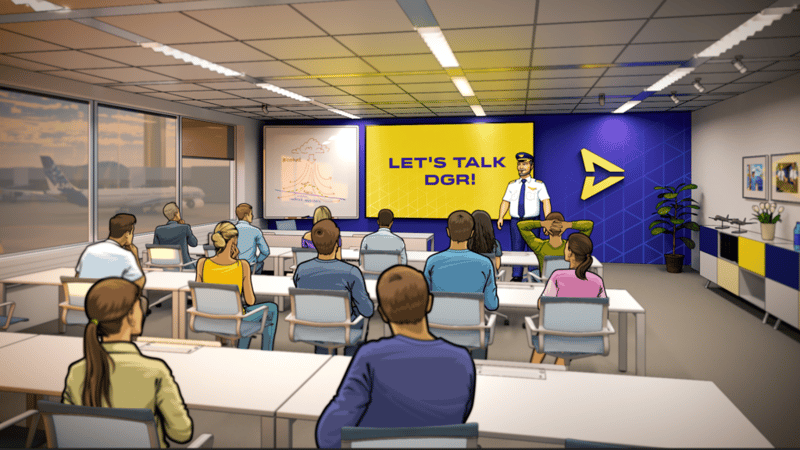Times flies when you’re having fun…
It is hard to believe Scandlearn started the project to change its learning process over 2,5 years ago. Even before the Authority decided on the competency-based approach for dangerous goods training, Scandlearn discussed how to change online training to make it more enjoyable, effective, and engaging.
Those who have followed Scandlearn over the past 22 years have seen progress to nicer and smoother graphics which we have received great feedback from our customers. With the Scandlearn competency-based training (CBTA) platform, Scandlearn will take the next step in producing high-quality training.
We are very excited that the International Civil Aviation Organization (ICAO) decided a couple of years back that we must change our dangerous goods training program and implement CBTA. Changing the dangerous goods training program will require a lot of work by the operator, but the outcome will benefit the whole community of dangerous goods.
We will, of course, write more about this in future blogs but for now, let’s focus on the upcoming Competency-Based Training and Assessment (CBTA), which will be valid 1st of January 2023.
Why change the Dangerous Goods Training Programme?
You might wonder why we need to change the old classic dangerous goods training programme and switch to a competency-based training programme. Good question, and let me explain why a CBTA approach is a better way of learning.
Then we can say that the other 50% is not helpful/useful for that staff and the employer has spent 50% extra cost for the course and the staff have been absent from their work 50% longer than needed which is also, a cost for the employer.
If you are an employer, you need to send some of your staff to train for dangerous goods. Let’s say your staff attends a course which takes a week. They learn a lot during that week and return to the employer inspired and start their work. After a while, they realize that they are only using 50% of the knowledge they were taught during the course. Then we can say that the other 50% is not helpful/useful for that staff and the employer has spent 50% extra cost for the course and the staff have been absent from their work 50% longer than needed which is also, a cost for the employer. All this because the Authorities said in the past that we needed to train according to categories. These categories had a strict syllabus for what must be trained to fulfil that category.
This is what it’s all about. In the competency-based approach, you don’t have to train in this extra 50 % in the example above. You only need to train in what you do in your workplace.
I can see already the person responsible for the training in the airline smiling. Maybe thinking, what do my pilots do in my airline. When you think about it, the only thing they do with the dangerous goods is to receive and sign the NOTOC on the flight deck; in case of emergency, the pilots must know what to do and inform ATC and ground staff and maybe write a report once in a while. You are now thrilled and think I can do a course about that which will only take 10 minutes….
Hold your horses; it is not that easy. ICAO has also decided that it is good for your pilot and cabin crew to have a little more understanding of the subject than in the above example. Therefore, a knowledge matrix must be followed, given a more in-depth understanding.
But maybe you start to get the idea of knowing the advantages of CBTA compared to the old way.
What is Competency-Based Training and Assessment (CBTA)?
Well, I have to make you disappointed because there is no easy way to explain this concept.
If you try to dig into the documents provided by ICAO, you will probably be very confused at first glance. These documents give you a lot of helpful information, but reading them for the first time is tough to understand if you are not already familiar with the CBTA concept.
If you are a Scandlearn customer, we have informed you several times in our newsletters about the concept, and we will, of course, continue to do that.
If you need help implementing competency-based training and Assessment (CBTA) for your organization Scandlearn has already developed an intelligent solution. Sign up or contact us today.
If you continue reading, we will now dig a little deeper into the dangerous goods training programme with its CBTA approach.
Scandlearns new learning approach that aligns with CBTA
Over the last couple of years, we have continued to develop our Learning Management System (LMS) and worked with the LMS to adopt our new learning approach that will also be aligned with the requirements of the CBTA approach.
Our new learning concept will be more user-friendly, delightful, and enjoyable to watch and include more interactive elements to fulfil the whole psychological level of design that will help the user remember and make training valuable.

Scandlearn has always been in favour of the CBTA approach. We find it very useful if implemented correctly. The CBTA training is nothing new; it has existed in many other industries, including the aviation industry.
I think I first came in contact with CBTA some 15 years ago in the airline company I used to fly for. It was implemented in our six-month mandatory simulator training.
However, when you start implementing the concept in your dangerous goods training programme, it can be very confusing when first reading about the competency-based approach (CBTA). I understand your concerns, but it will be much more straightforward after a while. Scandlearn is here to help.
We at Scandlearn realized that we live in the modern digital age where much technology is running our lives daily, such as apps, devices, and tech services. Therefore, training shouldn’t be much different to keep user stimuli. Our design is handmade with illustrations, all packaged in an attractive animated video format. We know it will bring a better value for our users and reflect back on our customers and the organizations.
Scandlearn, as a training provider, has transformed from a flat and gloomy layout to a bright, pleasant, and much more enjoyable look and design to more excellent and smoother graphics.
What is the ADDIE model?
As an educator, I guess you always have an idea when you decide about a new training. I think it all starts with an analysis. Why do I need this training? Maybe because it is required by the Authority, or one of your instructors approaches you, saying we need this.
Then you start thinking about how/who this training is for, what language it should be in. Should it be held in the classroom, online, as a combination, or just provided in a document?
As an educator, you need to answer all these questions and write down/document when creating a CBTA training. When you decide to develop such training, it might be a good idea before leaving the mission to an instructor to create it; give him more facts about what to develop.
In this design phase, you decide how your student will be assessed, maybe on written tests, online tests, oral tests, or just instructed/trained by an instructor. It is also good to tell the instructor how to develop the training, what shall be included in the course, how many modules, etc. Also, it is good to know what competency you wish your staff to have when completing the training. When you have provided your instructor with this information, it will be much easier for him to develop training according to your wishes.
When the training is developed, you may run a test course and see if the test students understand and get their feedback for the course, and make the final changes before you start to train your staff.
After your students have gone through the course, it is a perfect idea to evaluate the course. Did the students reach the goal? Do they know what to do? If not, it is a waste of money to develop such training.

What we have gone through, in short, is the famous acronym ADDIE. Analyse, Design, Develop, Implement and Evaluate. Most of us use this when developing a course without thinking about it. Am I right?
Using this model might help you develop your dangerous goods training programme according to the Authority’s wishes.
CBTA demands a strong and smart LMS
Scandlearn has used the ADDIE model when creating its approach to Competency-Based Training and Assessment (CBTA). We have used this to help our customers to have a smooth transition in changing their training programme.
Our platform (LMS) has remained the same over the years, with a few updated features. This will soon change since it requires a much stronger and smarter engine to handle individual data and evaluate results.
The standard online training is that your students go through a couple of pages and then pass a test at the end. This concept might not be the ultimate concept from a learning perspective.
What are their thoughts when going through the training? How do you measure that your students learned something? How do you work with the students during the training? Why have a page with no interaction?
Over the last couple of years, we have worked with these questions to implement a new pedagogical learning approach that we will hope will benefit the online industry and particularly the dangerous goods community. After all, safety is our number one priority.
The ‘A’ as in Assessment in a CBTA structure?
So far, we have talked about why we should switch to competency-based training. We have also discussed how we develop such a training programme and only briefly mentioned assessment.
The A in CBTA stands for assessment and is an important part. We have given a lot of thought to that at Scandlearn over the last couple of years. Most people dealing with dangerous goods training today and in the future will leave it to the operator to solve. We at Scandlearn would like to help the operator and provide a tool for assessing your training, which will save a lot of money for you as a customer. This tool will be included in the price for the dangerous goods CBTA course.
It is essential that the operator’s training department focus on the assessment part. It is the key to CBTA training. One of the important things with CBTA is continuous learning. Correctly handled, this will be a wonderful tool in developing your crew’s training. Let them grow and continuously learn something new.
When Scandlearn releases its new CBTA platform, it will include an assessment tool for all our customer training departments to use. With this tool, we will have the opportunity to measure how the students progress, what they think and what we can change in future training to enhance the learning experience. Therefore the assessors must know how to do this important work.
How to document your CBTA framework?
In competency-based training, you need to write down all you have in your head in a document when developing training and send it to your Authority for CBTA approval. If you are an Operator, most of you have to have an approved training program for CBTA in dangerous goods, even if you do not transport dangerous goods.
It is not only the Authorities who need this documentation; your students also need them.
The students must know what to expect from them and what their knowledge, skills, and attitudes should be. We have to equip the students with the right tool to manage their work, always having safety as the number one priority.
Therefore your company training manual (OM-D) needs to be updated with your brand new approach to competency-based training and assessment (CBTA).
This is what it is all about and I am very excited to hear your thoughts on CBTA. Never hesitate to contact Scandlearn if you have any questions or wish to share something.
At Scandlearn, we can hardly wait for the 1st of January 2023 to introduce the CBTA concept.
I wish you all the best
Bertil Tensing
Accountable Manager at Scandlearn

